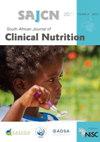Nursing practices associated with diagnosis of malnutrition in children under 5 years in West Rand District primary healthcare facilities
IF 0.8
Q4 NUTRITION & DIETETICS
引用次数: 0
Abstract
Background: Despite improvement in child health outcomes, undernutrition in children aged under five years continues to be a major public health problem, contributing to childhood morbidity and mortality. Objectives: The aim was to determine the knowledge and practice patterns used in the identification of malnutrition by nurses at PHC facilities. The attendance rates and the impact of in-house paediatric courses were also examined. Design: An observational, descriptive, cross-sectional study was undertaken from June to September 2018. Setting: The study was conducted at 36 primary healthcare clinics in the West Rand Health District Council Area, Gauteng, South Africa. Subjects: All nurses working with children aged under five years in the study clinics. Results: The response rate was 94% (49) with a mean age of 42.5 years (±9.7) with the majority (98%) being females. Nearly two-thirds (61%) of the participants had good knowledge, 33% had excellent knowledge and 6% had poor knowledge. The mean knowledge score was 20.3 (8–27, SD). The practice categories indicated that two-thirds of the participants (61%) displayed poor practices, and 21% had good practices whilst only 18% displayed best practices. The mean practice score was 4.5 (1.75, SD). There was no association between attendance at courses, knowledge scores and practice patterns. Conclusion: Most participants had good or excellent knowledge around issues of malnutrition. There was poor attendance on courses and there was no association between knowledge and attendance on the courses. More than 60% of the nurses had poor practice patterns and there was no association between knowledge, attendance on courses and practice patterns.西兰德区初级卫生保健设施中与5岁以下儿童营养不良诊断相关的护理做法
背景:尽管儿童健康状况有所改善,但五岁以下儿童营养不良仍然是一个主要的公共卫生问题,造成儿童发病率和死亡率。目的:目的是确定的知识和实践模式,用于鉴定营养不良的护士在初级保健设施。还审查了出勤率和内部儿科课程的影响。设计:2018年6月至9月进行了一项观察性、描述性、横断面研究。环境:研究在南非豪登省西兰德卫生区议会区的36个初级保健诊所进行。研究对象:所有在研究诊所与五岁以下儿童一起工作的护士。结果:有效率94%(49例),平均年龄42.5岁(±9.7岁),以女性居多(98%)。近三分之二(61%)的参与者知识良好,33%知识优秀,6%知识不佳。平均知识得分为20.3分(8-27,SD)。实践类别表明,三分之二的参与者(61%)表现出不良实践,21%的参与者表现出良好实践,而只有18%的参与者表现出最佳实践。平均练习得分为4.5 (1.75,SD)。课程出勤率、知识分数和练习模式之间没有关联。结论:大多数参与者对营养不良问题有很好的或很好的了解。课程出勤率很低,知识和课程出勤率之间没有联系。超过60%的护士实践模式较差,知识、课程出勤率与实践模式之间没有关联。
本文章由计算机程序翻译,如有差异,请以英文原文为准。
求助全文
约1分钟内获得全文
求助全文
来源期刊

South African Journal of Clinical Nutrition
NUTRITION & DIETETICS-
CiteScore
2.50
自引率
9.10%
发文量
21
期刊介绍:
1.The Journal accepts articles from all basic and applied areas of dietetics and human nutrition, including clinical nutrition, community nutrition, food science, food policy, food service management, nutrition policy and public health nutrition. 2.The Journal has a broad interpretation of the field of nutrition and recognizes that there are many factors that determine nutritional status and that need to be the subject of scientific investigation and reported in the Journal. 3.The Journal seeks to serve a broad readership and to provide information that will be useful to the scientific community, the academic community, government and non-government stakeholders in the nutrition field, policy makers and industry.
 求助内容:
求助内容: 应助结果提醒方式:
应助结果提醒方式:


